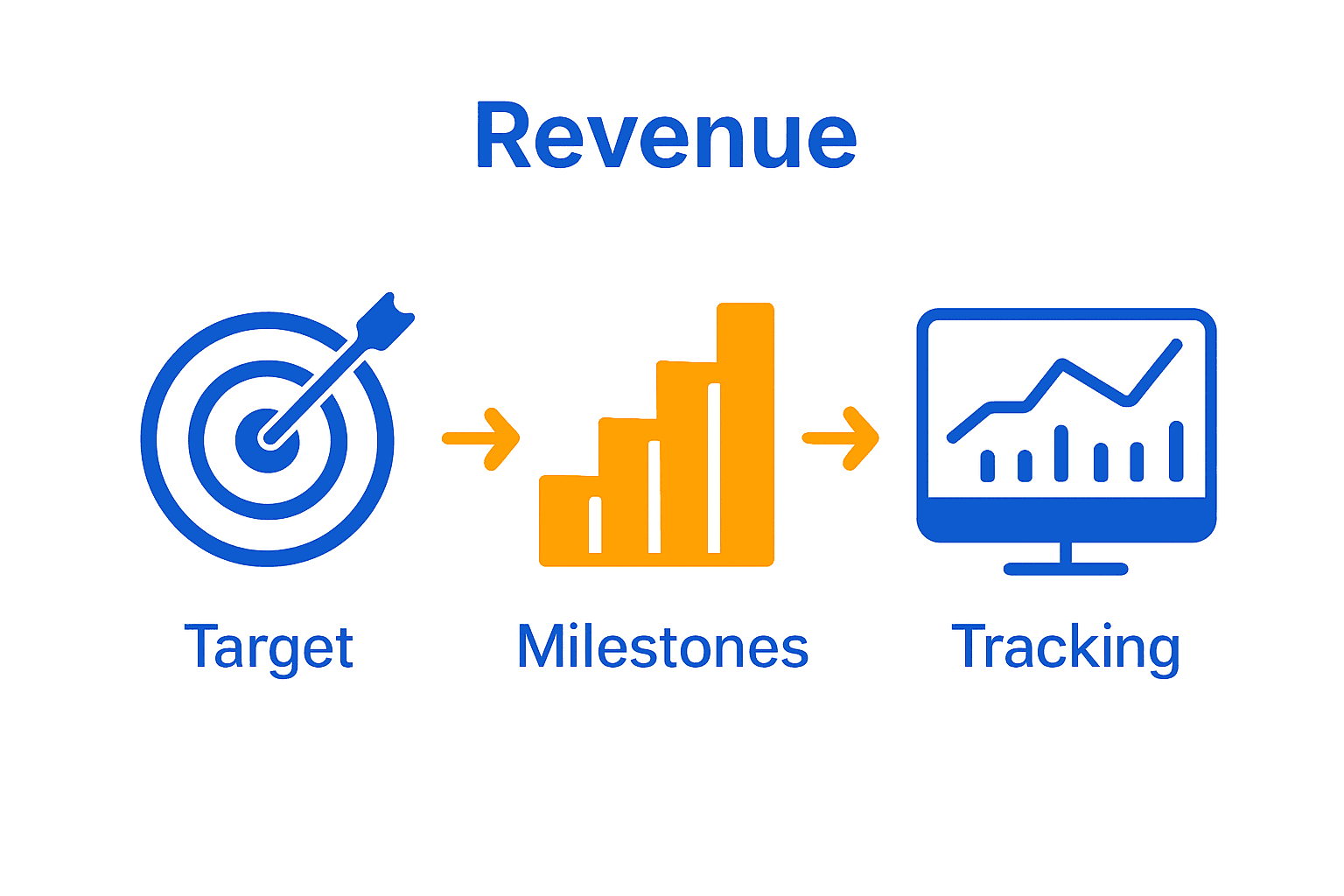
Setting financial goals is fundamental as nearly half of small businesses fail to meet their financial goals within the first year, according to the Small Business Administration. If you are a solopreneur, knowing how to set and track realistic revenue targets can mean the difference between steady growth and constant stress. By mastering clear financial planning and choosing the right tools, you can turn uncertainty into strategic progress and keep your business moving confidently forward.
Table of Contents
- Step 1: Define Your Revenue And Profit Targets
- Step 2: Analyze Your Current Financial Position
- Step 3: Break Down Goals Into Actionable Milestones
- Step 4: Select Tools To Track Goal Progress
- Step 5: Review And Adjust Your Financial Plan
Quick Summary
| Key Point | Explanation |
|---|---|
| 1. Set clear financial targets | Establish specific revenue and profit goals to guide your business growth effectively. |
| 2. Analyze your financial position | Conduct a detailed assessment of your assets, liabilities, and cash flow patterns to understand your business health. |
| 3. Break goals into milestones | Divide annual financial targets into quarterly and monthly milestones to track progress systematically. |
| 4. Choose appropriate tracking tools | Use the right financial tracking tools to simplify monitoring and analysis of your business performance. |
| 5. Review and adapt regularly | Schedule quarterly reviews to reassess goals and make adjustments based on actual performance and market changes. |
Step 1: Define your revenue and profit targets
Establishing clear financial targets is your roadmap to sustainable business growth. In this section, you will learn how to craft realistic revenue and profit goals that align with your solopreneur aspirations.
Start by analyzing your current financial situation. According to the Small Business Administration, forecasting sales, costs, and profits is fundamental for successful financial planning. Break down your potential income streams by listing all services or products you offer and their current pricing.
Calculate your baseline monthly income from existing clients or previous work. Project potential growth by considering factors like your service rates, expected number of clients, and potential market expansion. Aim to create both conservative and optimistic financial scenarios.
For profit targets, subtract your business expenses from gross revenue. This includes operational costs like software subscriptions, marketing expenses, professional development, and taxes. Your goal is to identify not just how much you can earn but how much you can actually keep.
Pro Tip: Research from the Small Business Entrepreneurs Council suggests reviewing your financial targets quarterly. Markets change rapidly for solopreneurs.
Remember that your first set of financial targets is a starting point. Be prepared to adjust as you gain more business insights and experience. Realistic goal setting builds confidence and provides clear direction for your entrepreneurial journey.
In the next step, we will explore strategies to track and achieve these carefully crafted financial targets.
Step 2: Analyze your current financial position
Understanding your financial landscape is crucial for strategic business planning. In this step, you will conduct a comprehensive assessment of your current financial health to create a solid foundation for future growth.
According to the Small Business Administration, creating a balance sheet is essential for capturing a precise snapshot of your business finances. Start by gathering all your financial documents including bank statements, income records, expense receipts, and tax documents.
List out your business assets such as cash reserves, equipment, digital tools, and any investments. Next, document your current liabilities like outstanding invoices, subscriptions, monthly recurring expenses, and any business loans. Calculate your total equity by subtracting your total liabilities from your total assets.
Pay special attention to your cash flow patterns. Track your monthly income and categorize your expenses into fixed costs (like software subscriptions) and variable costs (such as marketing or project specific expenses). Look for opportunities to reduce unnecessary spending and optimize your financial resources.
Pro Tip: Create a separate business bank account to simplify tracking income and expenses.
Consider using spreadsheet tools or accounting software to help organize and visualize your financial data.

Regular financial analysis helps you make informed decisions and identify potential areas for improvement.
In the next step, we will translate these financial insights into actionable strategies for business growth.
Step 3: Break down goals into actionable milestones
Transforming your financial vision into reality requires strategic planning and precise goal segmentation. In this step, you will learn how to convert your broader financial objectives into specific, manageable milestones that drive consistent progress.
According to the Small Business Administration, understanding financial statements is crucial for setting and achieving specific financial goals. Begin by breaking down your annual revenue target into quarterly and monthly objectives. For instance, if your yearly goal is $60000, divide this into $5000 monthly increments.
Create a timeline with clear checkpoint markers. Assign specific metrics to each milestone such as number of new clients, average project value, or percentage of income growth. This approach transforms abstract goals into concrete targets you can actively pursue.
Prioritize your milestones based on their potential impact and feasibility. Some goals might require sequential achievement while others can be pursued simultaneously. Consider potential obstacles and build flexibility into your planning to accommodate unexpected business dynamics.
Pro Tip: Use the SMART framework for milestone creation Specific Measurable Achievable Relevant and Time bound objectives.
Track your progress systematically. Update your milestone spreadsheet monthly to monitor performance and make necessary adjustments.
Celebrate small victories to maintain motivation and momentum.

Learn more in our guide on setting business goals that can help you refine your strategic approach.
In the next step, we will explore strategies for maintaining financial discipline and adapting your plan as your business evolves.
Step 4: Select tools to track goal progress
Choosing the right tools can transform your financial tracking from a chore into a strategic advantage. In this step, you will explore and select digital resources that simplify monitoring your business financial goals.
According to Entrepreneurial Funding Resources, multiple tutorials and templates exist to help solopreneurs monitor financial progress effectively. Begin by evaluating your specific tracking needs. Consider factors like budget complexity, reporting requirements, and your technical comfort level.
Spreadsheet tools like Google Sheets or Microsoft Excel remain powerful options for detailed financial tracking. They offer customizable templates where you can design dashboards tracking income, expenses, client metrics, and progress toward specific financial milestones. Create color coded sections that provide immediate visual insights into your performance.
For more automated solutions, explore accounting software that integrates multiple financial functions. Look for platforms offering real time reporting, expense categorization, and potential forecasting capabilities. Prioritize tools that sync with your existing business banking and payment platforms for seamless data collection.
Pro Tip: Select a tool that grows with your business. Start simple and upgrade as your financial tracking needs become more complex.
Consider cloud based solutions that allow mobile access. This enables you to review financial progress anywhere ensuring you stay connected to your business goals even when working remotely.
Here’s a comparison of common financial tracking tools for solopreneurs:
| Tool Type | Key Features | Pros | Ideal For |
|---|---|---|---|
| Spreadsheet (Excel/Sheets) | Custom dashboards Manual data entry Templates available | Flexible Low-cost | Beginners Custom needs |
| Simple Accounting App | Automatic expense tracking Invoice management Basic reports | User-friendly Mobile access | Freelancers Service providers |
| Advanced Accounting Software | Real-time reporting Bank syncing Forecasting tools | Automated Scalable | Growing businesses |
Explore our business goal setting tool to complement your financial tracking strategy.
In the next step, we will discuss how to interpret your tracking data and make strategic adjustments.
Step 5: Review and adjust your financial plan
Financial planning is not a one time event but an ongoing process of refinement and adaptation. In this final step, you will learn how to critically evaluate your financial strategy and make informed adjustments that keep your business trajectory on track.
Schedule quarterly review sessions to analyze your financial performance systematically. During these sessions, compare your actual results against the milestones and targets you established earlier. Look beyond just the numbers examine the underlying trends and patterns that reveal deeper insights about your business performance.
Break down your review into key performance indicators. Assess your revenue streams client acquisition rates profit margins and expense patterns. Identify areas of unexpected success or potential challenges. Were there months where you significantly outperformed or underperformed your initial projections? Understanding these variations provides critical intelligence for future planning.
Be prepared to recalibrate your financial goals based on real world performance. If certain revenue streams are consistently stronger than anticipated consider reallocating resources or developing those specific service offerings. Conversely if some strategies are not yielding expected results be willing to pivot and explore alternative approaches.
Pro Tip: Treat your financial plan as a living document. Rigidity can be more detrimental than occasional strategic shifts.
Consider external factors that might impact your financial landscape such as market trends economic shifts or changes in your industry. Stay informed about broader economic conditions that could influence your business strategy.
Explore our business goal setting guide for additional strategic planning insights.
Remember financial planning is about creating sustainable growth not achieving perfection. Each review is an opportunity to learn refine and strengthen your business foundation.
Take Control of Your Financial Goals with Fluum
Setting clear financial targets and tracking your progress step-by-step can feel overwhelming as a solopreneur. You want to hit your revenue and profit milestones while managing expenses and client relationships without losing focus or time. Fluum understands these challenges and acts as your AI-powered co-founder, helping you automate and simplify daily operations so you can concentrate on growing your business.

Start turning the financial goals outlined in this guide into actionable results by using Fluum’s all-in-one platform. Manage your sales funnels, client bookings, payments, and marketing effortlessly in one place. Make smarter decisions with easy-to-use tracking tools that align perfectly with your milestones. Don’t wait for the right moment—the time to scale your solopreneur business is now. Explore Fluum’s pricing plans and unlock the tools designed for your success. Discover how to set and achieve stronger business goals with our business goal setting guide and get started today.
Frequently Asked Questions
How do I start setting financial goals as a solopreneur?
To start setting financial goals, first analyze your current financial situation, including income and expenses. Create realistic revenue and profit targets based on existing clients and market growth potential, and aim to develop both conservative and optimistic scenarios.
What are the key steps to analyze my current financial position?
Analyze your current financial position by gathering all financial documents, including bank statements, income records, and expense receipts. List your business assets and liabilities, and calculate total equity to understand your overall financial health.
How can I break down my financial goals into actionable milestones?
Break down financial goals by dividing your annual revenue target into smaller, manageable quarterly and monthly milestones. For example, if your goal is $60,000 annually, set monthly targets of $5,000 to track your progress effectively.
What tools can help me track my financial goals?
Choose tools such as spreadsheet software for customizable tracking or accounting applications that provide automated features. Start with a simple tool that fits your needs, and consider upgrading as your financial tracking requirements grow.
How often should I review and adjust my financial plan?
You should review and adjust your financial plan quarterly to evaluate performance against your established goals. During each review, analyze key performance indicators and be prepared to recalibrate your objectives based on actual results and market changes.
Recommended
- Fluum | Effective Stress Management Techniques for Busy Professionals
- Fluum | How to Onboard Clients Effectively for Lasting Success
- Fluum | Master Managing Multiple Projects for Success
- Fluum | Build Your Brand with a Branding Builder in 2025
- Fluum | 7 Customer Retention Examples to Boost Your Business
- 7 Essential Business Goals Objectives For Solopreneurs
- Transform42 New


